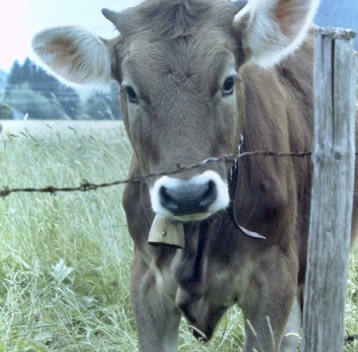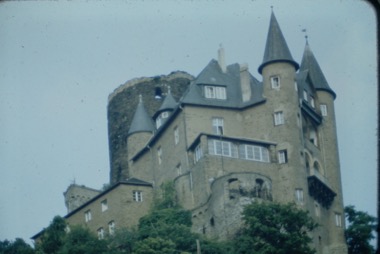Sorting photos and memories
02/12/20 02:11
For most of our married life, I have owned single lens reflex cameras. I’ve had a string of different cameras, but have stuck with the same lens system throughout my adult life. When we lived in Chicago I had the opportunity to study photography with Life magazine photographer Archie Lieberman and learned, among other things, darkroom skills. In the class, we used black and white film. The class standard was an 11 x 14 print, mounted. We did not frame our classroom prints, but they were gallery displayed for the class. Class members quickly learned to purchase 35mm film in 100’ rolls, roll our own cassettes for our cameras, process our own negatives and make our own prints. The school had a darkroom that was available 24/7 and we could schedule darkroom times that fit our needs.
I enjoyed the darkroom work, but wanted to have color images as well. The natural next step for me was to learn to process color film. The processes involved were much more complex. Whereas developing black and white negatives was a three chemical process, color slides required a minimum of six chemical baths. The easiest color film to process was Kodak E-6, sold as Ektachrome. It was available in 100’ rolls, though the cost was much higher than black and white film.
Color slides were, however, a good way for us to have and display our pictures. We obtained a slide projector and would set up shows for friends and family. On rare occasions we would have a print made from a color slide, and I even did some color printing myself, but color prints were expensive and the slides worked well to share our photographs. It was natural to us because both of our parents had slide projectors as well as many aunts, uncles and cousins, so we were used to home slide shows.
 The summer that I completed my doctorate my sister and her husband were also on an academic schedule. My father was exploring retirement at the time and he proposed that we all take a 6-week trip to Europe. He and my mother had many friends in Europe and there were some savings to traveling in a group of six. The lowest-cost plane tickets between my parents home and Europe were from Calgary, Alberta to Amsterdam. We drove to Calgary and flew to Holland, where we rented a Volkswagen van and drove around the continent, including traveling by ferry from France to England and back to Belgium. It was a wonderful trip and we have lots of memories.
The summer that I completed my doctorate my sister and her husband were also on an academic schedule. My father was exploring retirement at the time and he proposed that we all take a 6-week trip to Europe. He and my mother had many friends in Europe and there were some savings to traveling in a group of six. The lowest-cost plane tickets between my parents home and Europe were from Calgary, Alberta to Amsterdam. We drove to Calgary and flew to Holland, where we rented a Volkswagen van and drove around the continent, including traveling by ferry from France to England and back to Belgium. It was a wonderful trip and we have lots of memories.
For that trip, I planned that I would allow myself 72 pictures per day. That is a total of about 3,000 pictures. I didn’t take quite that many and I processed and mounted the slides myself. All said and done, I had about 1,200 images that were “keepers” to remind us of our trip. Those slides have lived in slide boxes for a little over 42 years now, coming out only occasionally for family viewing.
They are joined by all of the other slides we took in the years before we took up digital photography.
They are joined by a huge number of slides that my mother took.
They are joined by a huge number of slides that my father-in-law took.
Both my mother and Susan’s father kept a lot of their slides in carousels and both had two different projector brands and two different types of carousels.
 When it came time to move the sheer volume of three different projectors and boxes and boxes of carousels was just too much, so we kept one projector and two carousels for that projector and boxed the slides into more compact boxes. Even so, the slides take up considerable space in our garage, where they are temporarily living.
When it came time to move the sheer volume of three different projectors and boxes and boxes of carousels was just too much, so we kept one projector and two carousels for that projector and boxed the slides into more compact boxes. Even so, the slides take up considerable space in our garage, where they are temporarily living.
Our goal now is to digitize the slides and sort them on the computer so that we can keep the images that are most valuable to us and organize the images into a format where they can be accessed by future generations.
That means that we have tens of thousands of slides that have to be scanned individually, files to copy to the computer and organize into “albums,” data to add to the images so that they can be identified, and indexes of slides to scan and save as well. It is a huge job. If I do it right, when I get done we will have transformed boxes and boxes of images that are rarely viewed into digital files that can be accessed by others and take up very little physical space.
I started yesterday. Working for a couple of hours on two evenings, I’ve scanned about 2,000 images. I wasn’t very organized in choosing where to start. I simply started in the box that had the scanner when we moved. It had about 5,000 slides in it as well. The first box I opened contained the slides from our 1978 trip to Europe. Since I look at each slide as it is scanned and am organizing them into albums, I have ready-made trips down nostalgia lane as I scan. Last night we enjoyed an impromptu slide show on the computer monitor and remembered stories from more than four decades ago.
The quality of some of the images is poor. This is due to a combination of the limitations of E-6 film, which tends towards the blue side of the spectrum, inconsistencies in the chemical and temperatures of processing, and the length of time the images have been stored. Most of them can be restored digitally, but that is another process that takes considerable amounts of time. My goal right now is to get the images digitized so they can be preserved. Editing will occur over time as we access the images.
It already has been a good exercise in memory. The images do pass the Marie Kondo test. They do delight me. It is just that I have a lot more years of living and have collected a lot more images than she. I am also the custodian of the images of previous generations, something that doesn’t fit into her organizational scheme at all.
For now, I prefer to keep my memories and preserve the records of the past. I’m unlikely to become a minimalist any time soon.
I enjoyed the darkroom work, but wanted to have color images as well. The natural next step for me was to learn to process color film. The processes involved were much more complex. Whereas developing black and white negatives was a three chemical process, color slides required a minimum of six chemical baths. The easiest color film to process was Kodak E-6, sold as Ektachrome. It was available in 100’ rolls, though the cost was much higher than black and white film.
Color slides were, however, a good way for us to have and display our pictures. We obtained a slide projector and would set up shows for friends and family. On rare occasions we would have a print made from a color slide, and I even did some color printing myself, but color prints were expensive and the slides worked well to share our photographs. It was natural to us because both of our parents had slide projectors as well as many aunts, uncles and cousins, so we were used to home slide shows.

For that trip, I planned that I would allow myself 72 pictures per day. That is a total of about 3,000 pictures. I didn’t take quite that many and I processed and mounted the slides myself. All said and done, I had about 1,200 images that were “keepers” to remind us of our trip. Those slides have lived in slide boxes for a little over 42 years now, coming out only occasionally for family viewing.
They are joined by all of the other slides we took in the years before we took up digital photography.
They are joined by a huge number of slides that my mother took.
They are joined by a huge number of slides that my father-in-law took.
Both my mother and Susan’s father kept a lot of their slides in carousels and both had two different projector brands and two different types of carousels.

Our goal now is to digitize the slides and sort them on the computer so that we can keep the images that are most valuable to us and organize the images into a format where they can be accessed by future generations.
That means that we have tens of thousands of slides that have to be scanned individually, files to copy to the computer and organize into “albums,” data to add to the images so that they can be identified, and indexes of slides to scan and save as well. It is a huge job. If I do it right, when I get done we will have transformed boxes and boxes of images that are rarely viewed into digital files that can be accessed by others and take up very little physical space.
I started yesterday. Working for a couple of hours on two evenings, I’ve scanned about 2,000 images. I wasn’t very organized in choosing where to start. I simply started in the box that had the scanner when we moved. It had about 5,000 slides in it as well. The first box I opened contained the slides from our 1978 trip to Europe. Since I look at each slide as it is scanned and am organizing them into albums, I have ready-made trips down nostalgia lane as I scan. Last night we enjoyed an impromptu slide show on the computer monitor and remembered stories from more than four decades ago.
The quality of some of the images is poor. This is due to a combination of the limitations of E-6 film, which tends towards the blue side of the spectrum, inconsistencies in the chemical and temperatures of processing, and the length of time the images have been stored. Most of them can be restored digitally, but that is another process that takes considerable amounts of time. My goal right now is to get the images digitized so they can be preserved. Editing will occur over time as we access the images.
It already has been a good exercise in memory. The images do pass the Marie Kondo test. They do delight me. It is just that I have a lot more years of living and have collected a lot more images than she. I am also the custodian of the images of previous generations, something that doesn’t fit into her organizational scheme at all.
For now, I prefer to keep my memories and preserve the records of the past. I’m unlikely to become a minimalist any time soon.
